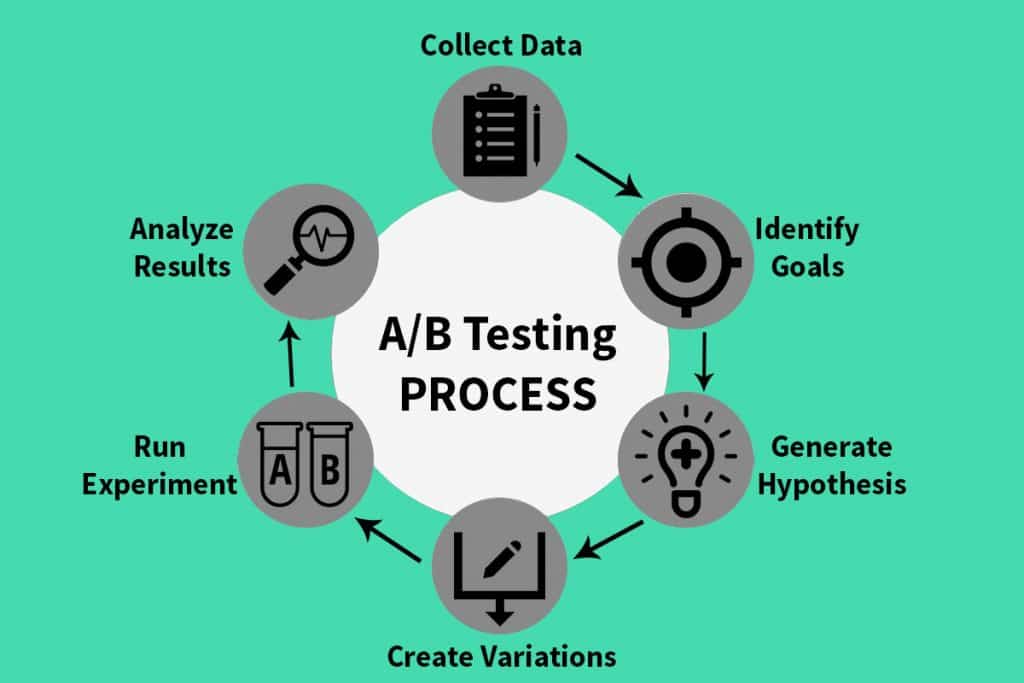A/B testing, also known as split testing, refers to a randomized experimentation process wherein two or more versions of a variable (web page, page element, etc.)
1. Test the Right Items :
One of the most important websites testing best practices is to test items that make a difference to the bottom line. For example, HubSpot suggests you optimize the pages people visit most:
- Home page
- About page
- Contact page
- Blog page
Or you may want to focus on your key lead generation pages. That means optimizing opting forms on your:
- Webinar signup page
- E-book landing page
- Lead magnet page
2. Pay Attention to Sample Size :
- If you don’t perform your test on enough people, you won’t get reliable results. If one campaign gets 150% more engagement, that’s great.
- Unless your total traffic was 5 readers. Then you actually don’t have much reliable data after all because your test sample is too small.
- One of the best ways to work out the ideal sample size is to use A/B Test, sample size calculator. Put in your current conversion rate, plus the percentage increase you’d like to see, and it will automatically calculate the number of visitors you’ll need for your A/B test.
3. Schedule Your Tests Correctly :
- Test scheduling is one of the most crucial A/B testing best practices.
- Here’s why: if you’re not testing apples against apples, you can’t trust the results.
- In other words, in order to get reliable results, you’ll need to run your A/B tests for comparable periods.
- Don’t forget to account for seasonal peaks and plateaus. Testing your traffic over Black Friday and comparing it to a regular ol’ Tuesday in February probably won’t give you the most reliable data.
- To find out how your traffic performs over a couple of months, login to Google Analytics. Go to Audience » Overview. The section you’ll want to focus on is the date range in the top right-hand corner.
- Change the period to Last 30 days:
- Then click on Compare To and the previous 30 days will automatically be selected
- Click Apply and you’ll get a quick snapshot of traffic patterns:
- This will give you a better idea of traffic patterns so you can select an ideal period to run your A/B test.
4. Nail Your Test Duration :
- Test duration is another essential factor in determining the reliability of your results. If you’re running a test with several variants and want 400 conversions, you’ll need to test for a longer time than you would for a test with one variant and 100 expected conversions.
- Use this chart from Digital Marketer to work out the ideal duration for split testing your website opting forms.
5. Test One Element at a Time :
- One golden rule of A/B testing forms and web pages is to test one element at a time.
- If you’re testing an opting form for marketing, test for changes in the headline, the changes in the call to action, OR changes in the number of form fields.
- Again, notice the emphasis on “or” rather than “and.” It should just be one.
- This is the only way you’ll know for sure if there is ONE element that makes a difference in your lead conversions.
6. Keep Variations Under Control :
- Related to that, don’t test too many variations at once. That’s a classic split testing mistake. As you saw in the Digital Marketer table, the more variations there are, the longer you have to run the tests to get reliable results.
- A/B testing best practices suggest you test between 2 and 4 variations at the same time. That gives the best balance of test duration and efficiency.
7. Pay Attention to the Data :
- We’ve all got gut feelings about how our marketing is performing, but the great thing about split testing is that it gives you data to either back up those feelings or to show that you’re wrong.
- Never ignore the data in favor of your gut. If you’ve followed our advice on how to do website site audit…you’ll get reliable data that’ll help you to improve conversions.


